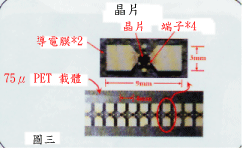- Wafer carriers -
This is the two conductive antennas attached to the chip that carries the RFID, usually printed on the PET film. <See FIG. 3> must be formed at a very high concentration. This method has a higher production cost but better softness.

For the wafer to work, an antenna must be connected. This type of antenna printing is a value-added service for printers, because only this can reduce the manufacturing cost of RFID tags. By directly printing the antenna on the package or sticker, it is possible to use less material to save costs and reduce the number of processing procedures. This is actually the lowest-cost production method. Handling the processing of sensitive wafers in this way to suit their equipment and operations is indeed the best opportunity for printers
- the mode of transmission -
RFID devices can be operated at different frequencies depending on various applications, and low frequency (LF) and high frequency (HF) frequencies have been applied to boxes and stickers. The printing and processing industry can use low-frequency or high-frequency tags for production, and the clamping of various RFID parts will continue to develop in a simple and reliable manner.
However, such printed RFID tags also have the potential to limit the integrated circuit and reduce the additional value. This is due to the complexity of the antenna design. The LF and HF antennas require extremely high conductivity and usually require solid state Metal foils are not available for printing of conductive inks.
Most of the current developments are focused on ultra-high frequency (UHF) tags, which are based on cost considerations and reading range, data transmission, tag size, and durability considerations in logistics and transportation.
Now there are solvents, water-based, UV and other inks for flexographic gravure and screen printing. The use of high-solid conductive materials (usually silver pigments) for various degrees of drying/curing operations differs from general ink printing. UHF antenna printing requires 3-5 micron silver conductive inks. .
- Clipping of stickers -
The simplest and most economical way for printers to manufacture wet RFID stickers is to use existing printing machines for production operations (see Figure 4).

Because the wet RFID sticker itself is like a roll of printed self-adhesive stickers, and it is like a general sticker stuck on the box, the workflow is the same as printing ordinary stickers, and then the release paper It is peeled off and automatically stuck in the correct position of the box. With the sticker, this RFID tag is properly placed under the sticker—the back of the label leaves the adhesive layer, and then the release paper is affixed again. The processing operation is completed.
The use of self-adhesive stickers for RFID is also designed to achieve the highest normal printing speed. The benefit of this process is that only this most convenient method can be used to clamp RFID, and it is not as expensive as a dry label, but it may be limited for extremely small jobs.
(to be continued)
Gym Equipment,Fitness Equipment,Strength Equipment
DDS Trade Co., Ltd. , http://www.lijiujia-sports.com